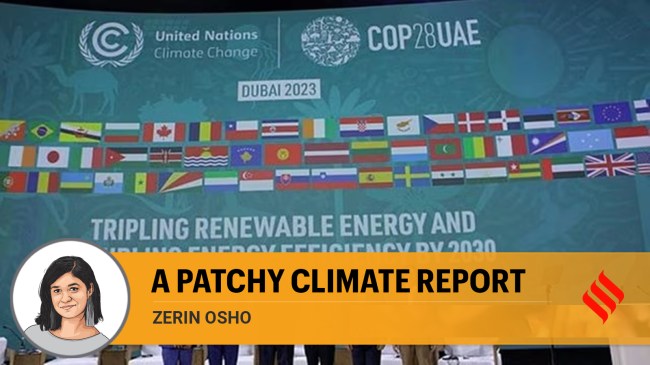Opinion COP28’s failure to frame binding commitments raises questions
2024 could be the third consecutive year for the country to be the fastest-growing large economy
 In 2021, the G20 countries collectively contributed 74 per cent of global emissions. While the EU, Japan, Canada, South Korea, and the UK, responsible for 13 per cent of global emissions, are reducing pollution, Russia, with 4.4 per cent of emissions, lacks significant emission-cutting initiatives. (Representational Image)
In 2021, the G20 countries collectively contributed 74 per cent of global emissions. While the EU, Japan, Canada, South Korea, and the UK, responsible for 13 per cent of global emissions, are reducing pollution, Russia, with 4.4 per cent of emissions, lacks significant emission-cutting initiatives. (Representational Image) Among a slew of pledges at the COP28 in Dubai, India signed none. Instead, it endorsed two declarations of intent — one related to low-carbon hydrogen and its derivatives, and the other focusing on making finance available, accessible, and affordable. However, these pledges are undermined by the reluctance of countries to frame them as binding agreements. This year’s marquee phrase, “transitioning away”, projected as historic, but arguably not very different to the earlier “phase out”, prompts scrutiny of the COP’s impact on countries’ actions and raises questions about the efficacy of the annual event.
The UN predicts a temperature increase between 2.5 and 2.9 degrees. Even if this year’s pledges are implemented, the world will still exceed the 1.5 degrees Celsius target set at COP21 in Paris eight years ago. Calculations of per capita emissions since the Rio Earth Summit in 1992 (where UNFCCC was established) reveal that the average American emitted nearly 700 tonnes of GHG between 1992 and 2019, surpassing the global average by over threefold. To meet climate goals, the US must exceed its current commitment to halve emissions by 2030 and achieve net zero by 2050. Similarly, the average Chinese emitted around 200 tonnes during the same period, which aligns with the global average. However, China’s continued construction of coal-fired power stations has led to rising emissions, necessitating improvements in its pledge to reach peak emissions by 2030.
In 2021, the G20 countries collectively contributed 74 per cent of global emissions. While the EU, Japan, Canada, South Korea, and the UK, responsible for 13 per cent of global emissions, are reducing pollution, Russia, with 4.4 per cent of emissions, lacks significant emission-cutting initiatives.
India, Brazil and Indonesia, accounting for 19 per cent of GHG emissions, face unique challenges. Considering their relatively modest historical contributions to global warming, expecting these countries to abruptly cut fossil fuel usage is unfair. The same applies to African countries, which contribute 8.7 per cent of emissions. A more effective strategy could be to have powerful countries set ambitious targets and influence others to follow suit.
A recent article by Christophe Jaffrelot and Hemal Thakker (‘A climate paradox’, IE, December 20) raises questions about the complexity of India’s energy pathways. Despite advancements in renewable energy deployment, coal investments persist, constituting approximately 45 per cent of India’s energy supply and 70 per cent of electricity production. The coal belt supports, directly or indirectly, around 15 million people. Out of 736 districts in India, nearly 280 have some form of coal dependency, with 35 entirely reliant on this fossil fuel. Many of these districts are characterised by underdevelopment and poverty. If the transition away from coal is not planned well, India could incur tremendous human, economic, and social costs.
Simultaneously, the economic viability of coal is diminishing as the cost of renewables plus storage is now lower than the new coal capacity. The focus must shift to upgrading the grid, overcoming financial challenges faced by loss-making discoms, and implementing regulatory mechanisms for solar mini-grids.
Despite consistent criticism of India’s coal stance, the final COP28 text has unfurled natural gas as a necessary bridge fuel. This overlooks the fact that methane, the primary component of natural gas contributes nearly 45 per cent of current warming. Although methane control gained momentum at COP26 in Glasgow, the voluntary nature of the agreement has meant that emissions have grown. While there was some progress at COP28, addressing methane is crucial for swift progress against climate change. India can address methane concerns by tackling anthropogenic sources through technology and improved water management. Existing technology can reduce 80 per cent of methane from paddy cultivation, while water management alone can cut 5 per cent of methane emissions in India’s air.
India has played a significant role in shaping the discourse by emphasising equity, climate justice and energy access.
It has successfully reduced emission intensity by 33 per cent and surpassed its 2030 target ahead of schedule. However, challenges persist in aligning policy with sustainable development.
As COP conferences continue, there is hope in technological advancements, global financial support and moral pressure exerted by countries. However, these alone may not avert a climate disaster. Leaders worldwide must strive for more robust commitments.
The writer is Director India Programme at the Institute for Governance & Sustainable Development






